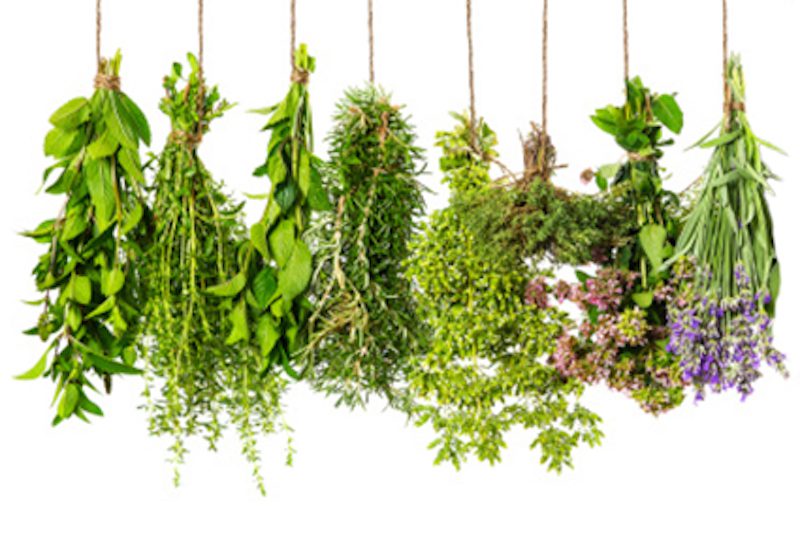Most Americans say “‘erbs.“ The British and Julia Child say “Herbs,” with the ‘H’ pronounced. Me? I just say it like whomever I’m with says it.
But Americans break the ‘a’ and ‘an’ rule with H’s all the time. (‘A’ before consonants, ‘An’ before vowels). In words where the ‘h’ is almost silent, they use ‘an.’ We seem to assume the Cockney accent, which hardly ever pronounces the “h,” when speaking. Think ‘ello, ‘eavens, ‘arry, etc. But you shouldn’t say “an ‘elping ‘and,” should you?
Like pronouncing the botanical names of plants; even if you  mispronounce a name, chances are that it won’t matter. You’ll probably be understood.
mispronounce a name, chances are that it won’t matter. You’ll probably be understood.
Grammar lesson over. So, what’s the difference between spices and herbs? Spices are from the seeds, bark or root of a plant. Herbs are from the green, leafy parts of a plant.
In our health conscious nation, herbs and spices have come to center stage in the kitchen. We can grow almost all the annual herbs down here, but perennial ones and spices are usually more tropical. So let’s take a look at the more familiar ones.
Before I go any further, let me say that you don’t have to go without the flavor of fresh herbs during the winter, or pay outrageous prices for them at the supermarket. You can freeze your harvest in freezer bags and just break off a piece as you need it. True, you’ll lose the crispness of fresh, but you won’t lose the flavor. Dried herbs are invaluable, but fresh isn’t always available.
Basil has so many varieties that you could fill your entire garden space with just basil. The most popular is the large leaved Genovese variety.
But I’m crazy about African Blue Basil. It’s stronger in flavor than most, but it’s the most popular pollinator in my garden. The good news is, the plant is sterile. It won’t set seeds and die down, so it continues to bloom its head off almost all year round. It will die down in harsh winters, but unless we have prolonged freezes, it will come back from roots. The bad news is, the plant is sterile. It doesn’t set seeds. The only way you can get a plant is from cuttings and they’re occasionally available at nurseries. It’s been around for a while, so chances are pretty good you know someone who will give you a cutting.
Many basil selections are quite ornamental, as well. ‘Thai’ basil is easy to germinate and grow down here, and the purple leaved variety is stunning.
My second favorite is Dill. It checks both boxes. You can use both its seeds and foliage. It will brighten up salads and new spring potatoes creamed with dill are sublime. A little lemon juice, dill and parsley sprinkled over rice elevates it to haute cuisine.
Oregano is hardy down here, as is Rosemary. Both are perfectly at home in a flower garden. Most herbs are. Rosemary comes in two forms, a shrub which can get 3 or 4 feet high, and creeping, which can be used as a ground cover. Sun and excellent drainage are essential. This is one you shouldn’t be without. Not only is it evergreen, but it has pretty blue flowers in spring. Sprigs of it are great BBQ skewers.
Dried parsley is hardly ever used by chefs. It’s too readily available all year. If you plant it, plant lots since butterfly caterpillars love it, too. It’s inexpensive at the markets after our growing season is over, so don’t worry about freezing it.
Culinary ginger can be grown here easily, but it’s not as ornamental or fragrant as the tall type we often grow down here; like Hedichium ‘Daniel Weeks’ or ‘Tara.’ Turmeric is another rhizome we can grow down here and use. We use the roots of these culinary plants. They can be frozen, too, and are as good as fresh.
Sage (Salvia) comes in many different varieties, but the culinary one we use to season our turkey stuffing is Salvia officinalis. There are salvias that smell like pineapple, mint, and even grape. All of them are flower-bed suitable.
Hard to believe, but today’s flower children have even found a sage you can chew or smoke. It has the same psychoactive properties as the more familiar wacky-backy. It isn’t native, so it definitely was purposefully brought here. It’s illegal in some states, so discretion prevents me from telling you what species it is. Ok, Ok!! It’s Salvia divinorum. If you really wanted to, you could have found it anyway . . .
Fennell can be used as an herb or a vegetable, and the seeds as a spice.
You can grow the saffron crocus down here. Some years. But considering that it takes over 4,000 plants to make an ounce of saffron, it’s not very practical!
Cilantro and Tarragon are both hard, if not impossible, to grow down here, but there are substitutes. Culantro is stronger than Cilantro, so use sparingly. Mexican or Texas Tarragon, (Tagates lucida) a member of the marigold family, is a pretty good substitute and a nice garden plant, but dried tarragon is almost as good as fresh, so just go with it.
I suppose now is the time to tell you to go through your dried herbs and throw most of them away. Yep, it’s almost certain that most are past their optimum use date, and stale herbs not only don’t add flavor, they can actually cause a muddy or ‘off’ flavor. Spices, though, are much more durable and the ones that haven’t yet been ground, like peppercorns, last almost indefinitely.
Although it’s not native, our beautiful Chaste Tree (Vitex agnus-castus) has been widespread here since the 1600’s. Its seeds were used by settlers as a seasoning like pepper. It’s called Chaste Tree because it was used in early monasteries to depress the libido of the monks. Couldn’t find anything about it being used in convents for nuns, so I guess women weren’t supposed to have libidos back then. We’ve come a long way, Baby!
Conversely, it’s said that coriander, cloves and cinnamon elevate the libido.
Decisions, decisions.







